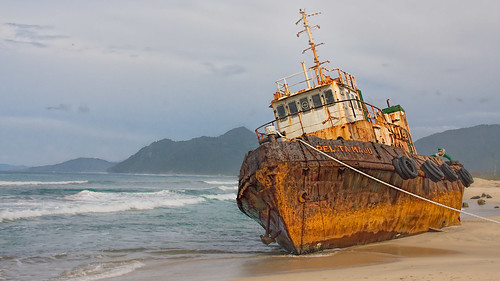
Tsunami wreck by robysaltori ![]()
![]()
“What kind of help do the victims of tsunami say they need to move on?”
“Two things in common.”
“First one is?”
“’Please tell the real story of ours.’ They do not believe real stories were told enough through the media and the government.”
“And second one?”
“’We want the Japanese society to learn something and change from the pains we had to get through.’ They want to confirm all the pains were not in vein and actually brought a change in society.”
Mina Son sincerely answered my questions.
Mina Son, a Korean-American documentary film director, visited Rikuzentakata in the Tohoku area in Japan. The small city was one of the hardest hit communities during 2011 Tohoku earthquake and tsunami. This city is also familiar with her. She lived and taught English ten years ago there.
There are still people she knew in the city. There are still citizens living in the devastated city. She spoke to them and filmed their stories. It is Rikuzentakata in 2014, her documentary film in production.
I recently attended her screening event, during my stay in Japan for Asia Leadership Fellow Program hosted by Japan Foundation and International House of Japan.
Tohoku is still in pain. After three years of disaster, still 270,000 refugees cannot go back home, according to Dr. OGUMA Eiji, professor in Keio University. 100,000 people are still living in temporary residences. Residents are leaving. Many communities lost as many as 30% of the population.
The economic foundation collapsed. The government is pouring money to create public work for construction. This calls criticism since it makes residents heavily dependent on the subsidies and only empowers local interest groups, not individual victims.
“If this continues, the communities might become ghost towns.” said Dr. OGUMA.
Large-scale disasters fully reveal the problems a society faces. The economy in Tohoku was already losing its dynamism even before the tsunami. Younger generations were leaving, so as large industries. Being an ultra-aged society, residents depended more and more on public works. Tsunami only accelerated the process and revealed the future of the society with unsolved problems, according to Dr. OGUMA.
I find Sewol in Rikuzentakata. They look different. One is a ferry that sank in the sea with 304 innocent passengers including 250 high-school students. The other is a small city in Tohoku hit by an unprecedented natural disaster.
But they are similar at the same time.
Look at Okawa Elementary School in Tohoku. Seventy-four innocent children out of 108 students and ten teachers out of 11 were found dead. Investigation Committee published a report in February 2014. They were standing still on the playground of the school for 50 minutes even after they were warned to leave. They just did not know what to do without detailed instructions, which were not given at the time.
The innocent students on Sewol were waiting in their rooms while the ferry was completely sinking in the sea. The initial announcement was ‘do not move.’ No follow-up was given. Most students just followed the instruction.
These are two tragedies very different in appearance but strikingly similar in deep causes. They show what we need to do after these overwhelming tragedies. They show what the victims really want in the end.
The victims believe the public still does not know the truth. They hope their pains meant something to the society. They can only move on when the society learns from the pains, changes, and moves on.
Korea is still on April 16th. Families of Sewol victims shout against the government. Pro-government demonstrators shout against the families. The national assembly is not in operation. Still, many questions remain unanswered.
Now, both political parties agreed in enacting the special Sewol bill. Bipartisan investigation committee will be launched.
The committee should remember two things.
First, fully reveal what really happened. Answer all the questions raised. Do this until the families can accept.
Two, fully reveal social problems of Korea, which were shown during the accident and the rescue. Do this until the society learns something and starts to change.
Investigation should not be about asking legal responsibilities of a few people involved. But it should be about asking social responsibilities of all the citizens in the country.
What will Korean society have learned in three years from Sewol? Will they learn something from what Japan had to get through?